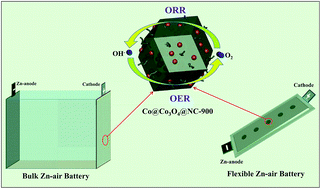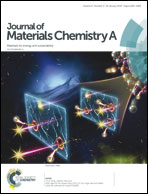In situ encapsulation of core–shell-structured Co@Co3O4 into nitrogen-doped carbon polyhedra as a bifunctional catalyst for rechargeable Zn–air batteries†
Abstract
The traditional oxygen reduction/evolution reaction (ORR/OER) catalysts are mainly noble metal-based materials, but their scarcity and instability impede their practical applications, especially in Zn–air batteries. Hence, identifying a bifunctional catalyst with low-cost and high-stability is very crucial for Zn–air batteries. Herein, we report a simple method to prepare core–shell-structured Co@Co3O4 nanoparticles encapsulated into N-doped carbon polyhedra by carbonization and controlled oxidation of metal–organic frameworks (MOFs), which are then applied as a bifunctional catalyst for Zn–air batteries. Using such a configuration, enhanced performances, including a high power density of ∼64 mW cm−2, a stable voltage profile over 80 h battery operation with four mechanical recharges, a small discharge/charge overpotential of ∼0.66 V and a long-life of 100 cycles for 200 h operation at 5 mA cm−2, have been achieved. These excellent performances can be attributed to abundant graphited carbon and CNTs, high N-doping, plentiful pores, the synergy between the semiconductive Co3O4-coating layer and the conductive Co bulk, and the uniform Co@Co3O4 nanoparticles in this catalyst which effectively improve electrical conductivity/ion transfer and further concertedly promote the catalytic activity towards the ORR/OER. Moreover, the belt-shaped polymer Zn–air battery with this catalyst also shows good electrochemical stability under different deformations.



 Please wait while we load your content...
Please wait while we load your content...